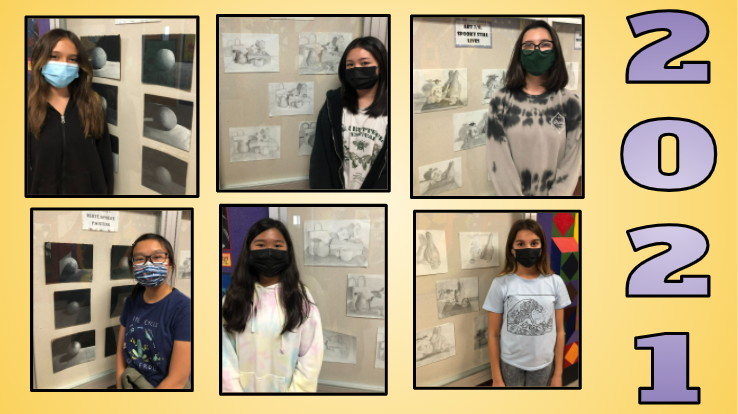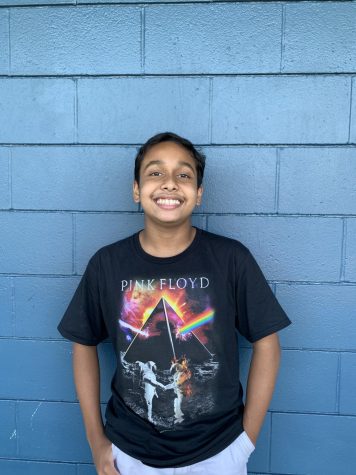Dla Ludzi Galleries From 2021
Interviewees from 2021 in front of their art pieces.
January 25, 2022
As we transition into the new year, it is fulfilling to look back on previous endeavors and acknowledge both successes and shortcomings. It can also be helpful to examine things like techniques used in the creative process to find out how and where to improve, as well as what to improve on.
A myriad of projects was added to the Dla Ludzi Gallery last year. The gallery features featuring drawings and paintings made by artists from the “Spooky Still Lives” project of Swihart’s Art ⅞ class and the “White Sphere” and “Winter Still Lives” projects of Swihart’s Advanced Art class, which all emphasized realistic visuals. The stipulation for these projects is that the artists had to focus on shading to achieve a perceivable realness in their projects. Scarlett Alexander of Art ⅞ began her project by lightly shading repeatedly until the perfect shade was reached, after which she would smear lightly using her finger.
Katherine Varipapa of Art ⅞ used a similar technique. After this step, Varipapa commented, “[I] started to draw the core shadow and then faded to the lighter tones and then erased where the highlights are.” Camille Harnage from the “White Sphere” project used a technique called “feathering” to make her project seem real, and went on to state, “This is a technique when you have a dry brush and once you mix the paint onto the cardboard you dry the brush.” Harnage also mentioned that it is important to frequently dry your paintbrush with a towel, even as the values in the painting get lighter.
Both Chelsia Campos and Sofia Alvarez of the “Winter Still Lives” project enjoys painting realistically, however, Campos prefers drawing objects rather than people. Grace Cheung of the “White Sphere” project believes that there is room for improvement in her painting skills, particularly when it comes to the blending process. Cheung stated that realistic art is something she will always be able to improve on. Harnage mentioned, “I could have improved more on capturing the right angle of the cast shadow on the sphere or the middle tones.” Both Varipapa and Alexander voiced that they could have improved on the shadows in their art piece, with Varipapa going on to cite the surrounding area of the objects as an area for possible improvement.
Alvarez and Campos both believe they have improved with shading and capturing light logic since being in Art ⅞. Throughout the “Spooky Still Lives” project, Varipapa noted improvements with proportions and shadows, while Alexander noted her improvement with shading. Harnage remarked, “I learned new ways to blend softly and capture the realism of the form,” and Cheung mentioned that she had become more confident in trying to paint realistically. Some tips mentioned by Varipapa include using one’s finger to blend shadows. Varipapa also mentioned a technique called the “squinting test,” where one looks back and forth between what they are drawing and the picture they are imitating to discern small differences between the images.
Harnage and Cheung emphasized constantly drying one’s brush, blending quickly, and adding the correct amount of paint when applying the “feathering” technique. Alvarez advises, “to make a value scale… to see what values you would need to make your artwork realistic,” as well as using correct proportions. In addition to utilizing correct proportions, Campos agrees on looking closely at a reference picture to notice small imperfections and changing details accordingly. Furthermore, Campos starts by applying different amounts of pressure to match shading, and lightly erases areas that are too dark.
It is clear how much effort these budding artists put into their endeavors, employing special techniques and tips in the process. Though there will always be some imperfections, using techniques like this can ensure the overall quality of said projects. All in all, these students tried their hardest to create beautiful, realistic art.


